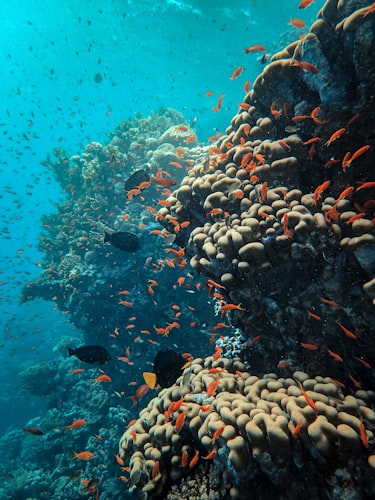It’s a mineral, a plant, and an animal! Here's How:
A coral reef is a colony for millions of tiny creatures called polyps. When they grow, each poly develops a hard, limestone skeleton on which the next generation polyps grow.
Coral polyps close up during the day, during night the reefs comes to life when the corals extend their tentacles into the water to trap the prey. Coral reefs cover 619,000 square kilometer of Earth’s surface.
Types of Coral Reefs
The three types of coral reefs are
1. Fringing reefs – Grows along seashores
2. Atolls – Grows around volcanoes which have not erupted for years
3. Cay – is an island completely made of corals
230 million years ago – Modern corals 1st developed in the early Triassic era
199 million years ago – At the end of the Triassic era, two third of the coral types were wiped out by
a climate change
18 million years ago – The formation of Australia’s barrier reef begins but its growth started and stopped several times
18,000 million years ago – Temperature on earth falls and sea water becomes trapped as ice in enormous glaciers,
causing sea levels to fall to their lowest levels ever. Any coral reefs exposed
during this period dies.
10,000 to 8,000
years ago – The reef we can see today begins to develop at the end of the last
great ice age. Melting of glaciers increases the level of sea.
An estimated 500 million people depend on
coral reefs for their food or livelihoods.
The carbon dioxide in water is converted
into limestone by coral reef.
Certain medicines are made using the chemical compound of the reef.
Without coral the water would rise,
destroying precious habitat.
It acts as a natural barrier that prevents
the strong waves and tides from coming ashore.
Different Shapes and Sizes of Reefs
Brain coral:
It has a giant brain like structure due to
the wrinkled edges.
Fan
coral:
A large lacy skeleton, formed by linkage of polyps of fan coral
Dead Mans Fingers:
The
tentacle of these polyps looks like decomposing fingers
Staghorn Coral:
This reef grows at a high speed, which
resembles antlers.
Great Reefs of the World
1. The Great Barrier Reef, Australia
One of the largest living structures on the
earth formed by the combination of 3,000 reefs which covers an area more than
2010 kilometer.
2. Kwajalein, Marshall Island
The world’s largest atoll that surrounds a lagoon 97 kilometer long.
3. Lighthouse reef, Belize
At the center of this Caribbean atoll lies the
Great Blue Hole, 145 meter deep.
Threats to Coral Reefs
1. Global Warming
Increase in the temperature rises the ocean level which leads to the death of algae in the coral reef.
2. Rising Seas
Global warming increases the level of sea
which will have a dramatic effect on coral reef.
3. Pollution
Reefs are damaged by the pollution of mining,
fertilizers, oil spills and pesticides.
4. Aquarium Trade
Some fishermen in Indonesia and Philippines use cyanide poison to attract fish, that they then use to decorate their museums.
Written By - V. Mary Adhasha
Edited By - Tushna Choksey





.jpeg)





2 Comments
useful content 👌
ReplyDeleteWow! Interesting
ReplyDelete